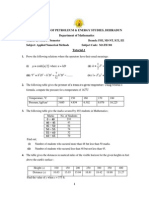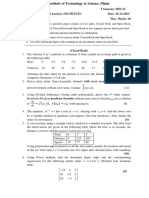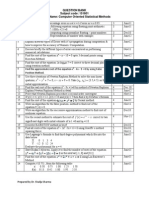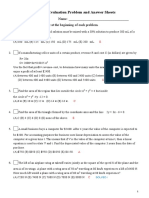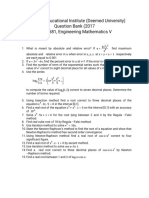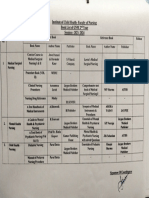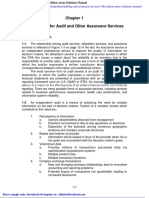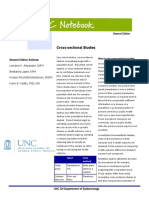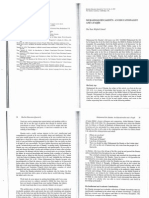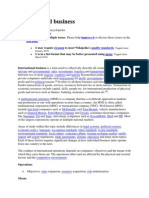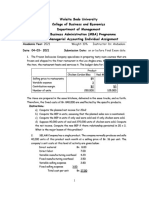Department of MathematicsPractice questions Numerical Methods
UNIVERSITY OF PETROLEUM & ENERGY STUDIES, DEHRADUN
Program B. Tech (All SoCS Batches) Semester I
Course Engineering Mathematics Course Code MATH 1036
1. Estimate the production of cotton in the year 1935 from the data given below:
Year, x 1931 1932 1933 1934 1935 1936 1937
Production, 17.1 13 14 9.6 ------- 12.4 18.2
f(x) in millions
2. The following table gives the pressure of a steam at a given temperature. Using Newton’s
formula, compute the pressure for a temperature of 1420C
Temperature, 0C 140 150 160 170 180
Pressure, kgf/cm2 3.685 4.854 6.302 8.076 10.225
3. The following table give the marks secured by 492 students in Mathematics;
Marks No. of Students
0 − 40 210
40 − 45 43
45 − 50 54
50 − 55 74
55 − 60 32
60 − 65 79
Find out; (i) Number of students who secured more than 48 but less than 50 marks.
(ii) Number of students who secured less than 48 but not less than 45.
4. Prove that the nth order divided difference of a polynomial of degree n is constant.
5. The table gives the distances in nautical miles of the visible horizon for the given heights in feet
above the earth's surface :
Height (x) 100 150 200 250 300 350 400
Distance (y) 10.63 13.03 15.04 16.81 18.42 19.90 21.27
Find the value of y when x = 375 ft.
6. The following are the mean temperatures (°F) on three days, 30 days apart round the periodsof
summer and winter. Estimate the approximate dates and values of maximum temperature in
summer and minimum temperature in winter.
1
� Summer Winter
Day
Date Temperature Date Temperature
0 15 June 58.8 16 December 40.7
30 15 July 63.4 15 January 38.1
60 14 August 62.5 14 February 39.3
7. The function y f ( x ) is given at the points (7, 3), (8, 1), (9, 1) and (10, 9). Find the value of
y for x 9.5 using Newton Divided Difference interpolation formula.
8. Use Newton’s divided difference interpolation to find the interpolating polynomial for the
function y= f(x) given by
X -1 1 4 6
f(x) 5 2 26 132
9. The following table gives some relations between steam pressure and temperature. Find the
pressure at temperature 372.10 using interpolation formula.
T(in degree Celsius) 361 367 378 387 399
P 154.9 167.0 191.0 212.5 244.2
10. Apply Newton formula to find the value of f (0.2) from the following table which gives the
x
1 x
2
value of f ( x )
2
e
0
2
dx at intervals of x 0.5 from x 0 to x 2 .
x 0 0.5 1.0 1.5 2.0
f ( x) 0 0.191 0.341 0.433 0.477
11. Using appropriate formule for interpolation, estimate the number of persons earning wages
between $ 60 and $ 70 from the following data:
Wages ($): Below 40 40—60 60—80 80—100 100—120
Number of people: 250 120 100 70 50
(in thousands)
12. Given the record of height from the earth’s surface for a rocket at intervals of time in a
laboratory of ISRO. Assuming that the height of atmosphere is 90 km, find the time when the rocket
leaves the atmosphere, by using backward formula.
Height 65 75 85 95
(km)
Time 30 34 36 37
2
� (sec)
13. Estimate the production for 1961 and 1971 from the following data:
Year: 1960 1962 1964 1966 1968 19701972
Production: 200 220 260 300 350 400 430
14. Apply Newton Divided difference interpolation formula to find f 5 given that
f 1 2, f 2 4, f 3 8, f 4 16, f 7 128 .
15. Use Newton-Gregory forward difference formula to obtain the interpolating polynomial 𝑓(𝑥)
satisfying the following data:
x: 1 2 3 4
f(x): 26 18 4 1
16. If p, q, r, s are the successive entries corresponding to equidistant arguments in a table, show that
when the third differences are taken into account, the entry corresponding to the argument half
way between the arguments at q and r is A B 24 , where A is the arithmetic mean of q and
r and B is arithmetic mean of 3q – 2p – s and 3r – 2s – p.
17. Given the following table, find 𝑓(𝑥) as a polynomial in power of (𝑥 − 5).
𝑥 0 2 3 4 7 9
𝑓(𝑥) 4 26 58 112 466 922
18. Estimate the production at the end of the year 1968 from the following data:
Year 1961 1962 1963 1964 1965 1966 1967
Production 210 215 222 230 245 260 270
19. A reservoir discharging water through sluices at a depth h below the water surface area A for
various values of H is given below:
H (ft) 10 11 12 13 14
A (sq. ft) 950 1070 1200 1350 1530
If t denotes time in minutes, the rate of fall of the surface is given by
dH 48 H
,
dt A
estimate the time taken for the water level to fall from 14 to 10 ft. above the sluices.
20. A solid of revolution is formed by rotating about the x axis, the lines x 0 & x 1 and a curve
through the points with the following co-ordinates:
x 0 0.25 0.5 0.75 1
y 1 0.9896 0.9589 0.9089 0.8415
3
� Estimate the volume of the solid formed using Simpson’s rule.
21. Find by Bisection’s method, the positive root of the equation x3 x 2 x 100 0 correct to
three decimal places.
22. Let 𝑓(𝑥) be a function satisfying 𝑓 (𝑥) + 𝑓(𝑥) = 0 with the conditions 𝑓(0) = 0 and𝑓 (0) = 1
If 𝑔(𝑥) = 𝑓(𝑥) − 5𝑥 + 2 be another function depending on 𝑓(𝑥) then use Fixed point iteration
method to determine the smallest positive real 𝑥 for which 𝑓(𝑥) ≈ 5𝑥 − 2 is satisfied.
23. Let 𝑓(𝑥) be a non-zero function such that 𝑛 derivative of it is equal to the function itself. Find
the smallest positive root of the equation 𝑥𝑓(𝑥) = 1 by using method of False position.
24. The graph of y 2 sin x and y log x c touch each other in the neighborhood of point x 8 .
Find c and the coordinates of point of contact.
25. Consider the van der Waal’s equation
a
P 2 V b RT .
V
Compute the specific volume V of carbon dioxide at a temperature of T 300 0 K , given
P 1atom , R 0.08254 J ( Kg 0 K ) , a 3.592 , b 0.04267 (Use suitable method).
26. A slider in a machine moves along a fixed straight rod. Its distance x cm along the rod is given
below for various values of time t seconds. Find the velocity of the slider and its acceleration
when t 0.3 seconds.
t 0.0 0.1 0.2 0.3 0.4 0.5 0.6
x 3.013 3.162 3.287 3.364 3.395 3.381 3.324
27. Apply Regula False position method to solve the equation x 3 8 x 2 17 x 10 0 .
28. Find the smallest positive root of the equation 𝑥 + 9𝑥 − 18 = 0 correct to three decimal
places using Newton Rapshon method.
29. Find 𝑓 ′(2) and 𝑓 ″(2) from the following table:
𝑥: 0 1 3 6
𝑓(𝑥): 18 10 -18 40
30. In celestial mechanics, mean anomalyis a parameter relating position and time for a bodymoving
in a Kepler orbit and eccentric anomaly is a parameter that defines the position ofa body that is
4
� moving along an elliptic Kepler orbit. The Kepler equation of motion relating the mean anomaly
( M ) and the eccentric anomaly ( E ) of an elliptic orbit with eccentricity e is given by
M E e sin E . Given e 0.0167 (Earth’s eccentricity) and M 1 (in radians), compute E
using(a) Bisection method (b) Fixed-point iteration method and (c) Newton’s method(d) False
position method.
31. Find a real root of the equation 3 x sin x e x 0 by the method of False position correct to
three decimal places.
32. Find the root of the equation xe x cos x by Bisection method correct to four decimal places.
33. Find a real root of the equation f x x x 1 0 by using the fixed point iteration method
3 2
correct to three decimal places.
34. A river is 80 meters wide. The depth d in meters of the river at a distance ' x ' meter from
the bank is given by the following table:
x 0 10 20 30 40 50 60 70 80
d 0 4 7 9 12 15 14 8 3
Find the approximate area of cross section of the river using Simpson’s rule.
35. Find 𝑓 ′(1.1) and 𝑓 ″(1.1) from the following table:
𝑥: 1.0 1.2 1.4 1.6 1.8 2.0
𝑓(𝑥): 0.0 0.1280 0.5540 1.2960 2.4320 4.000.
40. Evaluate ∫ using
(i) Simpson’s 1/3 rule taking h = 1/4
(ii) Simpson’s 3/8 rule taking h = 1/6
Hence compute an approximate value of π in each case.
41. A train is moving at the speed of 30 m/sec. suddenly brakes are applied. The speed of the train
per second after t seconds is given by
Time (t): 0 5 10 15 20 25 30 35 40 45
Speed (v): 30 24 19 16 13 11 10 8 7 5
Apply Simpson’s three-eighth rule to determine the distance moved by the train in 45 seconds
42. Compute
5
� 1
xp
Ip dx for p 0, 1 .
0
x 3 10
Use Trapezoidal rule with number of points 3, 5 and 9.
43. A tank is discharging water through an orifice at a of depth x meter placed below the surface of
the water whose area is A m 2 . The following are the values of x for the corresponding values of
A:
A 1.257 1.39 1.52 1.65 1.809 1.962 2.123 2.295 2.462 2.650 2.827
x 1.50 1.65 1.80 1.95 2.10 2.25 2.40 2.55 2.70 2.85 3.00
Using the formula
3.0 A
(0.018)T dx ,
1.5
x
calculate time T , in seconds for the level of the water to drop from 3.0 m to 1.5 m above the
orifice.
44. Find a real root of the equation x 2 log e x 12 0 using Regula-Falsi method correct to
three decimal places.
45. Using Newton-Raphson method, find the real root of f ( x ) x sin x cos x 0 which is
near x correct to three decimal places.
1 1 1 x 1
46. Solve the equation AX B where A 1 2 2 , X y and B 1.5 by Gauss Seidal
1 2 3 z 3
method.
47. Solve the equations 10 x 2 y z 9, 2 x 20 y 2 z 44, 2 x 3 y 10 z 22 by Gauss
Jacobi method.
4 1 1 x 4
48. Solve the equation AX B where A 1 4 2 , X y and B 4 by Gauss Seidal
3 2 4 z 6
method.
49. Solve the equations 2 x y z 4, x y 2 z 2, x 2 y z 2 by Gauss Jacobi method.
50. Using Runge-Kutta method of fourth order, calculate y (0.1), and y (0.2) of the differential
dy
equation x y 2 , y (0) 1.
dx
6
�51. Using Runge-Kutta method of fourth order, calculate y (0.1), and y (0.2) of the differential
dy 2 xy
equation 1 , y (0) 1.
dx 1 x 2
52. Using Picard’s method, solve y 2 xy with x0 0, y0 1 up to third approximation.
dy
53. Find an approximate value of y when x=0.1, if x 2 y 2 and y=1 at x=0, using
dx
Taylor’s series method.
54. Use Euler’s modified method to find y(0.25) given that y xy , y(0)=1.
dy y2 x
55. Find y for x=0.1 and 0.2 for 2 given that y(0)=1 by Runge-Kutta method of
dx y 2 x
fourth order.
56. Use Euler’s method to find an approximate value of y(0.4) for the equation y x y ,
y(0)=1 with h=0.1.
57. Using Runge-Kutta method of order four, find y for x=0.1, 0.2, 0.3 given that
dy
2 xy 3 y 2 , y(0)=1.
dx
58. Apply Euler’s method to solve the differential equation y 3x y 2 at x=0.8, given that
y(0)=2, with the step size of 0.2.
59. Solve the following system of equations by using Gauss-Jacobi and Gauss-Seidel
iterative methods correct to 4 decimal places
20 1 2 X1 19 4 1 2 x 4
(i) 3 20 1 X 2 20 (ii) 3 5 1 y 7
2 3 20 X 3 27 1 1 3 z 3
10 4 2 x 12 5 1 2 x 2
(iii) 1 10 1 y 10
(iv) 3 4 1 y 2
5 2 10 z 3 2 3 5 z 10
60. Determine the 7th root of 30 by Bisection in the interval (1.62, 1.63) correct up to four
decimal places.
61. Determine the 5th root of 10 by Newton Raphson method correct up to six decimal places.
7
�62. Determine the 4th root of 20 by Regula False position method in the interval (2.11, 2.12).





